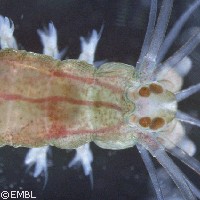Scientists shine a light on eye evolution
The first animal eyes could have been simple, two-celled affairs that allowed their bearers to sense the direction of light and move towards it, according to German research published in the latest edition of the journal Nature. The scientists arrived at their conclusion by studying the larvae of the marine ragworm Platynereis dumerilii. 'Platynereis can be considered a living fossil,' explained the lead author of the paper, Gáspár Jékely of the Max Planck Institute for Developmental Biology. 'It still lives in the same environment as its ancestors millions of years ago and has preserved many ancestral features. Studying the eyespots of its larva is probably the closest we can get to figuring out what eyes looked like when they first evolved.' Every day, the microscopic larvae of marine invertebrates such as worms, sponges and jellyfish swim upwards towards the light at the ocean surface. This ability to swim towards a light source is known as phototaxis, and the daily migration of the zooplankton is the largest transport of biomass on Earth. These minute animals' eyes are the simplest in existence, consisting as they do of just two cells: a photoreceptor cell and a pigment cell. Although they cannot form images, these 'proto-eyes' or 'eyespots' do allow the animal to accurately sense the direction of light. However, until now, the workings of these primitive eyes remained a mystery. In this latest study, the team found a nerve cell that links the photoreceptor cell of the eye and the cells that guide the larva's swimming motion. When the photoreceptor cell detects light, it sends an electrical signal down the newly discovered nerve to cells covered in cilia: thin, hair-like projections that beat the water and allow the animal to move. The second cell contains pigment and is responsible for the directional sensitivity of the eye by casting a shadow over the photoreceptor cell. The size and shape of the shadow varies according to the position of the light source, and this information is communicated to the cilia via the signal from the photoreceptor. 'These results provide, to our knowledge, the first mechanistic understanding of phototaxis in a marine zooplankton larva and show how simple eyespots regulate it,' the researchers conclude. 'For a long time, nobody knew how the animals do phototaxis with their simple eyes and nervous system,' commented Detlev Arendt of the European Molecular Biology Laboratory (EMBL). 'We assume that the first eyes in the animal kingdom evolved for exactly this purpose. Understanding phototaxis thus unravels the first steps of eye evolution.'
Countries
Germany



